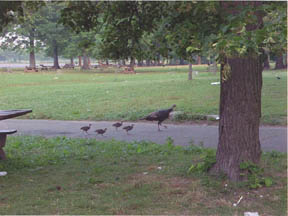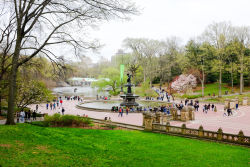Central Park
The Daily Plant : Friday, December 6, 2002
TALKING TURKEY

For Easter, people hunt eggs in Central Park. For Halloween, they enjoy the haunted house in Van Cortlandt Park. For Thanksgiving, why not count Turkeys in Pelham Bay Park?
Well, that’s just what happened this past Saturday with Youth Program Coordinator Maria Karpfinger of Van Cortlandt and Pelham Bay Parks, and 14 children from St. James Recreation Center. It was part of the "Put the Spirit back in the Holidays" programs in Pelham Bay Park. The series has included everything from holiday decorations made from natural objects to handmade gifts and, well, counting turkeys. What an unusual but fitting way to celebrate Thanksgiving by trying to sight and learn more about the Wild Turkey (Meleagris gallopavo), a bird that was missing in New York State for a century!
There have been numerous sightings in Pelham Bay Park of proud toms (the male of the species) and prouder hens with as many as seven poults (as you call a young turkey). PPS Ben Giannini reports, "I saw a dozen of them on the parkway adjacent to the stables a couple of weeks ago." In response to these viewings, a seasonal appreciation ritual was created.
On Saturday with maps in hand, the youngsters found the different sites they were visiting as they drove through the park. At the Bartow-Pell Mansion, we thought we saw one in the edge of the forest off the lawn. They walked up as possible only to find two caution markers.
The toms are the more stunning of the two with plumage that changes from rust to green or coppery gold with black-tipped breast feathers. The hens are basically brown with tan-tipped breast feathers. Males have spurs as long as two inches; females generally do not. The toms also have beards that drop from the middle of their chest, which can be as long as 16 inches, while 15 percent of the females have a smaller one.
Prior to disappearing from the state for a hundred-year stretch, the last Wild Turkey sighting on record was in the southwest region of New York in 1844. The bird’s disappearance was the result of hunting without limits and the clearing of forested land. Turkeys returned on their own to the southwest region of the state by the end of the 1940s, firmly established there by 1957.
In 1957, the New York State Department of Environmental Conservation (DEC) initiated a program to relocate Wild Turkeys to areas that were capable of sustaining them. Since then, the state population of turkey has grown from 2,000 in 1959 to more than 65,000 in 1990.
Though no wild turkeys were spotted by the group of youngsters last Saturday, they learned a lot about the species and fun was had by all.
Written by Maria Karpfinger
THIRTEEN YEARS AGO IN THE PLANT
(Friday, December 15, 1989)
TRICYCLES: THEY’RE NOT JUST FOR FUN
Tricycles have always been a part of park life. But now, the people behind the wheel aren’t quite so young—or small. They are Parks workers, who are using this innovative piece of park equipment to clean city parks.
CPW Edward Russell first suggested using oversized tricycles to help workers in a large park get from one location to another without a vehicle. Chief of Technical Services George Tacktikos liked the idea, and ordered five tricycles with baskets to carry tools and supplies.
QUOTATION FOR THE DAY
"A lot of people like snow. I find it to be an unnecessary freezing of water."
Carl Reiner
(b. March 20, 1922)












